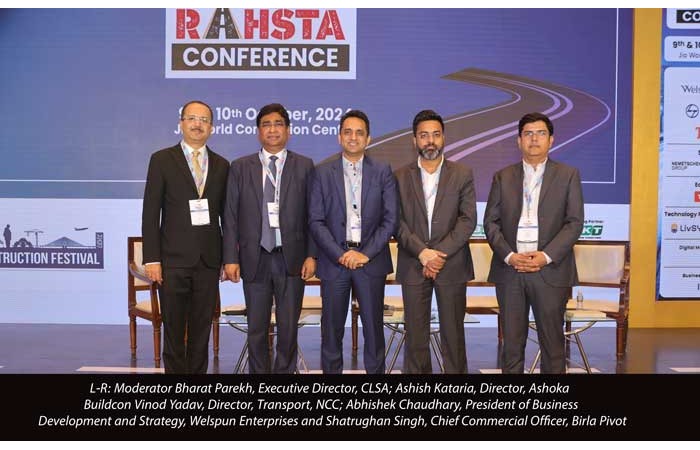
PM Gati Shakti addresses planning gaps in infrastructure projects
Launched to transform the nation’s infrastructure development, PM Gati Shakti is a groundbreaking initiative which emphasises the importance of collaboration among different ministries and stakeholders to create a cohesive infrastructure framework. By mapping over 900 layers of data related to existing and upcoming projects, it enhances project transparency and efficiency, significantly reducing logistical costs that currently account for 13-14 percent of India’s GDP.
Shining amid crisis
“India embarked on the $1.4 trillion of national infrastructure pipeline at a time when the world was a troubled place,” said Bharat Parekh, Executive Director, CLSA, adding, “As far as execution is concerned, like almost at the peak of Covid, clearly we changed the track of the last 30 to 40 years of subsidies and freebie-driven budgets to capex-driven economic recovery and that's what has set India as a shining star on the global map and with doubling of the capex in the budget, very clearly now the fruits are here for us to see where our growth is clearly different from the world. So what we are going to do today is to dig deeper into challenges to infrastructure assets from here on.”
The core of Gati Shakti
“The core objective of Gati Shakti is to address the significant planning gaps in infrastructure projects across the country,” said Vinod Yadav, Director (Transport) NCC, emphasising upon its focus on driving economic growth. In conclusion, Yadav summarised the vision of PM Gati Shakti as a transformative approach aimed at driving economic growth and sustainable development by creating a seamless synergy between infrastructure sectors, fostering innovation and reducing costs.
Unified data
“The private sector should benefit from the vast database and information available on the Gati Shakti portal,” said Abhishek Chaudhary, President of Business Development and Strategy, Welspun Enterprises, stressing the need for better DPRs and accountability and highlighting the significant progress made under PM Gati Shakti with over 900 layers of data already integrated into the portal. He called for the portal to be made accessible to consultants, financiers, developers and contractors which would further enhance project execution, enabling smoother operations and better-informed decision-making across India's infrastructure landscape. “The top-down approach has been well-executed but the bottom-up implementation, where the real work happens, still needs to catch up for the true potential of PM Gati Shakti to be achieved,” he concluded.
World class infrastructure
“It’s a fantastic concept at the macro level,” said Ashish Kataria, Director, Ashoka Buildcon, acknowledging the PM Gati Shakti initiative’s ability to streamline national infrastructure development and praising it for laying a strong structural foundation aimed at aligning efforts towards building world-class infrastructure while avoiding duplication of work. Kataria's comments highlighted the need for better coordination and foresight during the project planning and design stages to ensure the successful implementation of ambitious goals.
DPR challenges
Kataria emphasised that detailed project reports (DPRs), often prepared by consultants, are critical to a project's success but are frequently marred by oversight. “The problem is that consultants who draft these DPRs often miss key design elements or fail to engage essential stakeholders early on,” he noted, adding that this leads to demands for modifications like flyovers or Vehicle Overpasses (VOPs) once the project is already underway. He suggested that greater accountability from DPR consultants is necessary, proposing a system where consultants remain financially engaged until at least 25 percent of the project is completed. Concluding his remarks, Kataria commented on the Public-Private Partnership (PPP) model, stating that while it is often touted, “the first ‘P’—public—tends to disappear after the award of the concession,” underscoring the need for genuine collaboration between the public and private sectors.
Land acquisition delays
“Projects were awarded, but land acquisition did not happen,” said Shatrughan Singh, Chief Commercial Officer, Birla Pivot, emphasising that land acquisition continues to be a significant hurdle in project completion, drawing on his past experience. He recounted how he witnessed delays in the National Highways Development Programme (NHDP) due to insufficient land acquisition. “Designs were based on outdated data from 40 to 50 years ago, leading to severe complications during construction,” highlighting the need for more accurate and up-to-date data, he explained. On a more optimistic note, Singh praised the initiative as a substantial step forward in addressing these challenges. He said, “The nation is being master-planned in terms of industrial zones and multimodal transport, which is incredibly exciting.”
Leveraging technology
Singh highlighted the potential of technological advancements to improve project execution, noting that many issues faced on the ground can be mitigated through better technology adoption. He concluded by reiterating the importance of embracing technological advancements in project management to minimise delays and cost overruns, which he believes are linked to over 90 percent of projects not finishing on time. He summarised saying, “It’s all about working together to adopt technology for better project management and controls.”
The way ahead
The PM Gati Shakti programme, with its focus on transparency, efficiency and cost reduction, is poised to not only modernise infrastructure but also enhance India’s global competitiveness.


 +91-22-24193000
+91-22-24193000 Subscriber@ASAPPinfoGlobal.com
Subscriber@ASAPPinfoGlobal.com